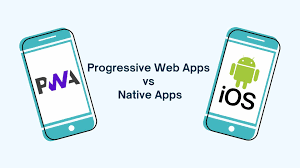Progressive Web Apps (PWAs) vs. Native Apps: Which One is Better for Your Business?
As mobile usage continues to dominate the digital landscape, businesses face a critical decision when developing their mobile strategy: should they build a Progressive Web App (PWA) or a Native App? Both options have their advantages and limitations, and the right choice depends on factors such as performance, user experience, cost, and business objectives.
Progressive Web Apps (PWAs) are web-based applications that offer an app-like experience without requiring users to download them from an app store. Built using standard web technologies like HTML, CSS, and JavaScript, PWAs can work offline, send push notifications, and load quickly, thanks to service workers and caching techniques. Since they run in web browsers, PWAs are platform-independent, meaning they can function on both iOS and Android without the need for separate codebases. This makes PWAs cost-effective and easier to maintain.
Native Apps, on the other hand, are developed specifically for a particular operating system—iOS or Android—using platform-specific programming languages like Swift for iOS and Kotlin for Android. They provide superior performance, seamless integration with device hardware, and a more immersive user experience. Features such as GPS, camera access, Bluetooth, and biometric authentication work optimally in native applications, making them ideal for high-performance and feature-rich applications.
One of the biggest advantages of PWAs is their accessibility. Users can access a PWA instantly from their browser, eliminating the friction of downloading an app from an app store. This leads to higher user engagement and retention. Additionally, PWAs have better discoverability since they can be indexed by search engines, allowing businesses to attract more organic traffic. For companies looking to reach a wider audience with minimal development costs, PWAs present a compelling option.
However, PWAs have some limitations compared to native apps. While modern browsers have improved their support for PWA features, certain device functionalities, such as advanced gestures, AR/VR capabilities, and deeper system-level integrations, are still more optimized for native applications. Additionally, some iOS restrictions prevent PWAs from utilizing full push notification capabilities, which can be a drawback for businesses relying on direct user engagement.
Native apps provide better performance, smoother animations, and enhanced security. Since they are built specifically for their respective operating systems, they are optimized for better speed and efficiency. Native apps also have direct access to the app store ecosystem, enabling businesses to leverage app store rankings, user reviews, and monetization opportunities.
Ultimately, choosing between a PWA and a native app depends on the business goals. If a company wants a cost-effective solution with easy accessibility, a PWA is a great choice. However, if an application requires high performance, deep system integration, and a rich user experience, a native app is the better option.
As mobile technology continues to evolve, hybrid solutions like Flutter and React Native are bridging the gap between web and native applications, providing businesses with greater flexibility. Whether businesses opt for a PWA, a native app, or a hybrid approach, prioritizing user experience and performance remains the key to mobile success.






